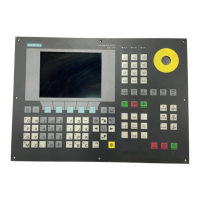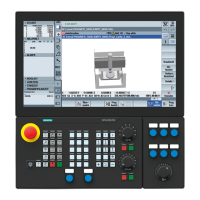P3: Basic PLC Program for SINUMERIK 840D sl
13.8 Structure and functions of the basic program
Basic Functions
Function Manual, 09/2011, 6FC5397-0BP40-2BA0
885
The assignments have been made as follows:
To symbolically program the interface signals, the interface data blocks must first be symbolically assigned using
the symbol editor.
For example, symbol "AxisX" is assigned to operand DB31 with data type UDT 31 in the symbol file.
After this input, the STEP 7 program can be programmed in symbols for this interface.
Description
Abbreviated symbolic names of the interface signals are defined in the two STL files NST_UDTB.AWL and
TM_UDTB.AWL.
In order to create the reference to the names of the interface signals, the name is included in the comment after
each signal.
The names are based on the English language. The comments are in English.
The symbolic names, commands and absolute addresses can be viewed by means of a STEP 7 editor command
when the UDT block is opened.
UDT assignments
UDT number Assignment to interface DB Significance
UDT 2 DB 2 Interrupts/Messages
UDT 10 DB 10 NCK signals
UDT 11 DB 11 Mode group signals
UDT 19 DB 19 HMI signals
UDT 21 DB 21 to DB 30 Channel signal
UDT 31 DB 31 to DB 61 Axis/spindle signals
UDT 71 DB71 Tool management: Load/unload locations
UDT 72 DB 72 Tool management: Change in spindle
UDT 73 DB 73 Tool management: Change in revolver
UDT 77 DB 77 MCP and HHU signals with standard SDB 210
UDT 1002 DB 2 extended alarms / messages (FB 1-Parameter
"ExtendAlMsg:=TRUE"
Note
Programs generated with an earlier software version that utilize the interface DBs described
above can also be converted into symbol programs. A fully qualified instruction for data
access e.g. "U DB31.DBX60.0" is then necessary here for (spindle/ no axis) in the program
created till now. This command is converted upon activation of the symbolics in the editor
"AxisX.E_SpKA".
Note
Unused bits and bytes are listed, for example, with the designation "f56_3".
• "56": Byte address of the relevant data block
• "3": Bit number in this byte

